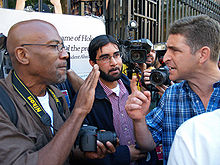Staring
Staring behavior can be considered as a form of aggression like when it is an invasion of an individual's privacy in certain contexts, or as a nonverbal cue to convey feelings of attraction in a social setting.For example, in the movie Superbad, the character Fogell is caught staring at a classmate’s exposed thong underwear, or a whale tail.This has been the subject of psychoanalytical studies on the nature of scopophilia, with a subsequent development in some aspects of feminist thought (see film, photography and voyeurism).Staring contests ('Stare-out') were featured as an animation in the first series of surreal BBC television comedy sketch show Big Train (aired in 1998).In season two, episode four of the Cartoon Network animated sitcom Regular Show, the main villain, "Peeps" (who is a large floating eyeball), is defeated by losing a staring contest.



visualconcentrationstreet harassmentdaydreamingSuperbadthong underwearwhale tailCM PunkDaniel Bryanaggressionstaring contesteye contactparanoiaWesternscopophobiaself-esteemflirtingJean-Paul SartreBeing and NothingnesssubjectivityscopophiliafeministphotographyvoyeurismSartreJohn L. SullivanJake KilrainpsychologicalCartoon NetworkRegular ShowFace-offIntimidationStare-in-the-crowd effectThousand-yard stareThe Washington Post